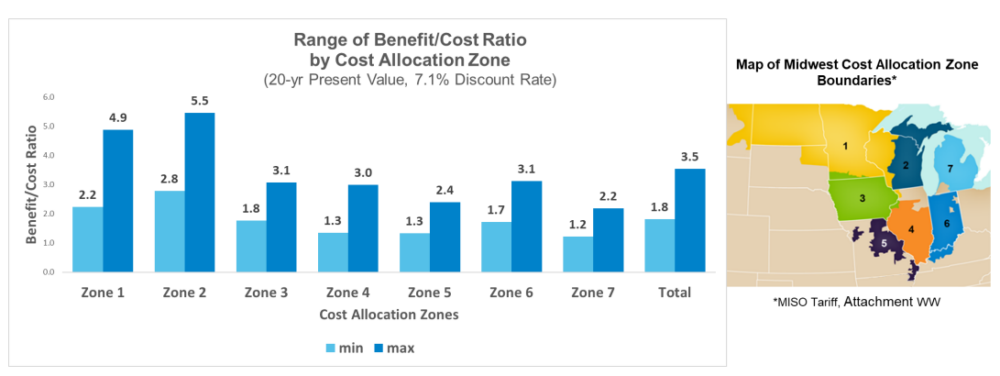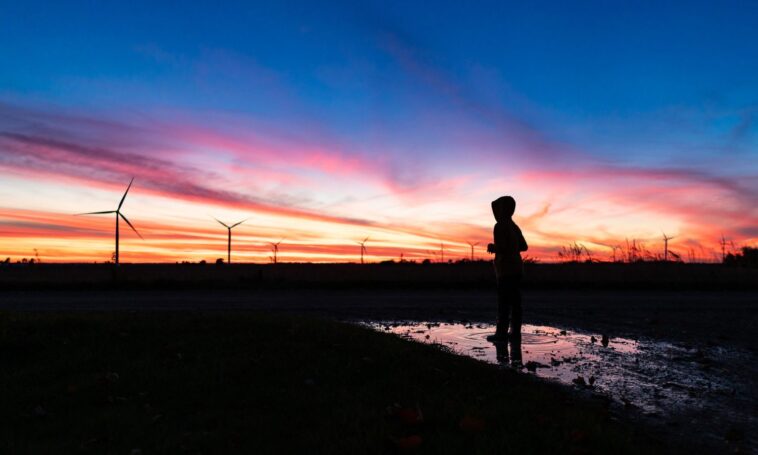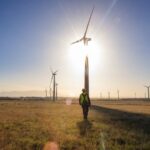Today, the MISO Board of Directors took the landmark step of approving what is likely the largest single investment in the history of the US power grid. For its part, the transmission advocacy group Clean Grid Alliance calls MISO’s action “the biggest regional grid upgrade ever in the United States.”
In 2022, the Midcontinent Independent System Operator (MISO)—the entity that runs the electric grid for much of the Midwest—rolled out a portfolio of transmission upgrades known as “Tranche 1” of its Long Range Transmission Planning initiative (see here for a summary of Tranche 1 and state-specific run-downs for Illinois and Michigan). Those projects are now in the process of being permitted by state commissions.
Today’s approval marks the next major step in MISO’s planning efforts. Dubbed “Tranche 2.1,” the package consists of 24 different projects representing nearly $22 billion in total investment. This round of upgrades will help unlock vast amounts of clean energy and strengthen the reliability and resilience of the power grid.
The 24 projects making up MISO’s Tranche 2.1 transmission upgrade portfolio. Source: MISO.
Across all the MISO “zones” in the Upper Midwest, analysis by the grid operator shows that the wide range of benefits from completing these projects outweigh their costs, even under a conservative approach that does not take into account the public health benefits of burning fewer fossil fuels (for a more in depth look at this, see my colleague Sam Gomberg’s explanation here):

A benefit/cost ratio greater than 1.0 means that the projects are estimated to provide benefits in excess of their costs; MISO’s projections show that for every dollar spent on the Tranche 2.1 projects, as much as $5.5 dollars will be returned in benefits. Source: MISO.
Let’s look further into what Tranche 2.1 means for a few key Midwest states: Illinois, Michigan, and Wisconsin.
Illinois
Totaling $2.9 billion in investments, the Illinois portion consists of three primary projects, including new 765 kilovolt (kV) transmission lines, a new 345 kV line, and work on existing substations. Extra-high voltage lines at the 765 and 345 kV levels allow electricity to travel over longer distances with less resistance—letting more electricity reach consumers and lowering costs.
In Illinois, MISO estimates that Tranche 2.1 will drive between 2,886 to 8,659 direct jobs and between $577 million and $3.2 billion in total economic output (with the ranges reflecting different economic impact calculation methodologies).
Clean Grid Alliance estimates that Tranche 2.1 will enable more than 15,000 megawatts (MWs) of new clean energy additions in Illinois, including nearly 10,000 MWs of wind power, more than 3,000 MWs of solar, and about 2,000 MWs of energy storage batteries. This is enough to power more than 3.5 million homes and create nearly 113,000 jobs.
Michigan
Totaling $2.7 billion in investments, the Michigan portion of Tranche 2.1 consists of three projects: two new 345 kV transmission lines in mid-Michigan and a new 765 kV line above the Indiana and Ohio borders.
In Michigan, MISO estimates that Tranche 2.1 will drive between 2,672 to 8,015 direct jobs and between $534 million and $2.9 billion in total economic output.
Clean Grid Alliance estimates that Tranche 2.1 will enable close to 8,000 MWs of new clean energy additions in Michigan’s Lower Peninsula, including about 2,500 MWs of wind power, more than 1,000 MWs of solar, and about 4,000 MWs of energy storage batteries. This is enough to power more than 1 million homes and create more than 52,000 jobs.
Wisconsin
Totaling $4.1 billion in investments, the Wisconsin portion of Tranche 2.1 consists of parts of six projects: two new 765 kV transmission lines from Minnesota and Illinois, portions of new 345 kV lines, and building new substations and upgrading existing ones.
In Wisconsin, MISO estimates that Tranche 2.1 will drive between 4,086 to 12,257 direct jobs and between $817 million and $4.5 billion in total economic output.
Clean Grid Alliance estimates that Tranche 2.1 will enable more than 6,600 MWs of new clean energy additions in Eastern Wisconsin and Michigan’s Upper Peninsula, enough to power 1.2 million homes and create close to 47,000 jobs. The Western part of Wisconsin is in a different MISO “zone” that also includes North Dakota and Minnesota—in those areas, the Tranche 2.1 projects are expected to enable a massive addition of nearly 30,000 MWs of clean energy that can power 7.7 million homes and create close to 230,000 jobs.
Transmission upgrades support Midwest states’ clean energy and climate goals
Illinois, Michigan, and Wisconsin all have ambitious goals to decarbonize their electricity generation, either through state legislative standards, executive orders, or utility planning.
As these states and others move into their clean energy future, transmission upgrades like those in MISO’s Tranche 2.1 are important not only for facilitating the transition but also for keeping our power grid stable and reliable while saving ratepayers money.
What’s Next?
MISO’s Tranche 2.1 projects will next proceed to state processes for further evaluation and siting and permitting review.
It is critical that Illinois, Michigan, Wisconsin, and other states continue conducting inclusive and accessible processes to hear from communities that may be affected by the projects, as they are doing now for MISO’s earlier-approved Tranche 1 projects.
MISO’s Long Range Transmission Planning process shows the benefits to states and ratepayers across the Midwest of investing in our electric grid. MISO must continue its work and proceed to additional phases required to build the modern transmission infrastructure we need for states and utilities to achieve their clean energy goals. Let’s celebrate today’s smart investments, and keep working toward a healthier, safer, more affordable electricity future.




GIPHY App Key not set. Please check settings